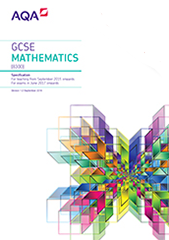3.1 Number
3.1.1 Structure and calculation
N1
Basic foundation content |
Additional foundation content |
Higher content only |
|---|---|---|
order positive and negative integers, decimals and fractions use the symbols =, ≠, <, >, ≤, ≥ |
Notes: including use of a number line. See also A22
N2
Basic foundation content |
Additional foundation content |
Higher content only |
|---|---|---|
apply the four operations, including formal written methods, to integers, decimals and simple fractions (proper and improper), and mixed numbers – all both positive and negative understand and use place value (eg when working with very large or very small numbers, and when calculating with decimals) |
Notes: including questions set in context.
Knowledge and understanding of terms used in household finance, for example profit, loss, cost price, selling price, debit, credit, balance, income tax, VAT and interest rate. See also R9
N3
Basic foundation content |
Additional foundation content |
Higher content only |
|---|---|---|
recognise and use relationships between operations, including inverse operations (eg cancellation to simplify calculations and expressions) use conventional notation for priority of operations, including brackets, powers, roots and reciprocals |
N4
Basic foundation content |
Additional foundation content |
Higher content only |
|---|---|---|
use the concepts and vocabulary of prime numbers, factors (divisors), multiples, common factors, common multiples, highest common factor, lowest common multiple, prime factorisation, including using product notation and the unique factorisation theorem |
Notes: prime factor decomposition including product of prime factors written in index form.
N5
Basic foundation content |
Additional foundation content |
Higher content only |
|---|---|---|
apply systematic listing strategies |
including use of the product rule for counting |
Notes: including using lists, tables and diagrams.
N6
Basic foundation content |
Additional foundation content |
Higher content only |
|---|---|---|
use positive integer powers and associated real roots (square, cube and higher), recognise powers of 2, 3, 4, 5 |
estimate powers and roots of any given positive number |
Notes: including square numbers up to
Students should know that and 1 million =
N7
Basic foundation content |
Additional foundation content |
Higher content only |
|---|---|---|
calculate with roots, and with integer indices |
calculate with fractional indices |
N8
Basic foundation content |
Additional foundation content |
Higher content only |
|---|---|---|
calculate exactly with fractions |
calculate exactly with multiples of |
calculate exactly with surds simplify surd expressions involving squares (eg ) and rationalise denominators |
N9
Basic foundation content |
Additional foundation content |
Higher content only |
|---|---|---|
calculate with and interpret standard form, where and is an integer |
Notes: with and without a calculator.
Interpret calculator displays.
3.1.2 Fractions, decimals and percentages
N10
Basic foundation content |
Additional foundation content |
Higher content only |
|---|---|---|
work interchangeably with terminating decimals and their corresponding fractions (such as 3.5 and or 0.375 and |
change recurring decimals into their corresponding fractions and vice versa |
Notes: including ordering.
N11
Basic foundation content |
Additional foundation content |
Higher content only |
|---|---|---|
identify and work with fractions in ratio problems |
Notes: See also R8
N12
Basic foundation content |
Additional foundation content |
Higher content only |
|---|---|---|
interpret fractions and percentages as operators |
Notes: including interpreting percentage problems using a multiplier. See also R9
3.1.3 Measures and accuracy
N13
Basic foundation content |
Additional foundation content |
Higher content only |
|---|---|---|
use standard units of mass, length, time, money and other measures (including standard compound measures) using decimal quantities where appropriate |
Notes: know and use metric conversion factors for length, area, volume and capacity.
Imperial/metric conversions will be given in the question.
N14
Basic foundation content |
Additional foundation content |
Higher content only |
|---|---|---|
estimate answers check calculations using approximation and estimation, including answers obtained using technology |
Notes: including evaluation of results obtained. See also N15
N15
Basic foundation content |
Additional foundation content |
Higher content only |
|---|---|---|
round numbers and measures to an appropriate degree of accuracy (eg to a specified number of decimal places or significant figures) |
use inequality notation to specify simple error intervals due to truncation or rounding |
Notes: including appropriate rounding for questions set in context.
Students should know not to round values during intermediate steps of a calculation. See also N14
N16
Basic foundation content |
Additional foundation content |
Higher content only |
|---|---|---|
apply and interpret limits of accuracy |
including upper and lower bounds |
